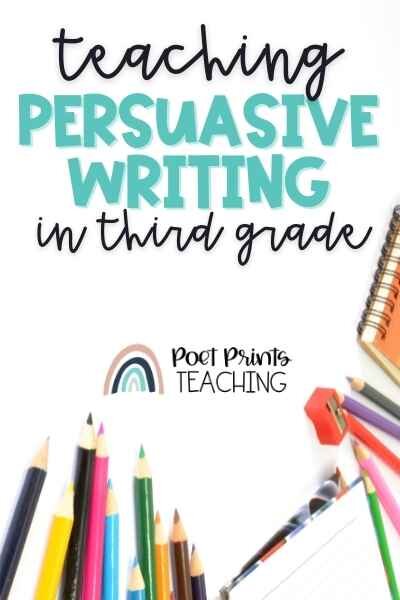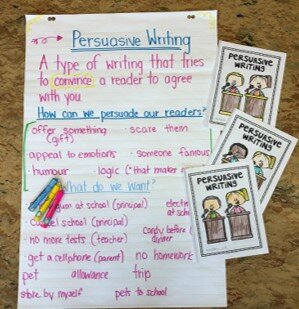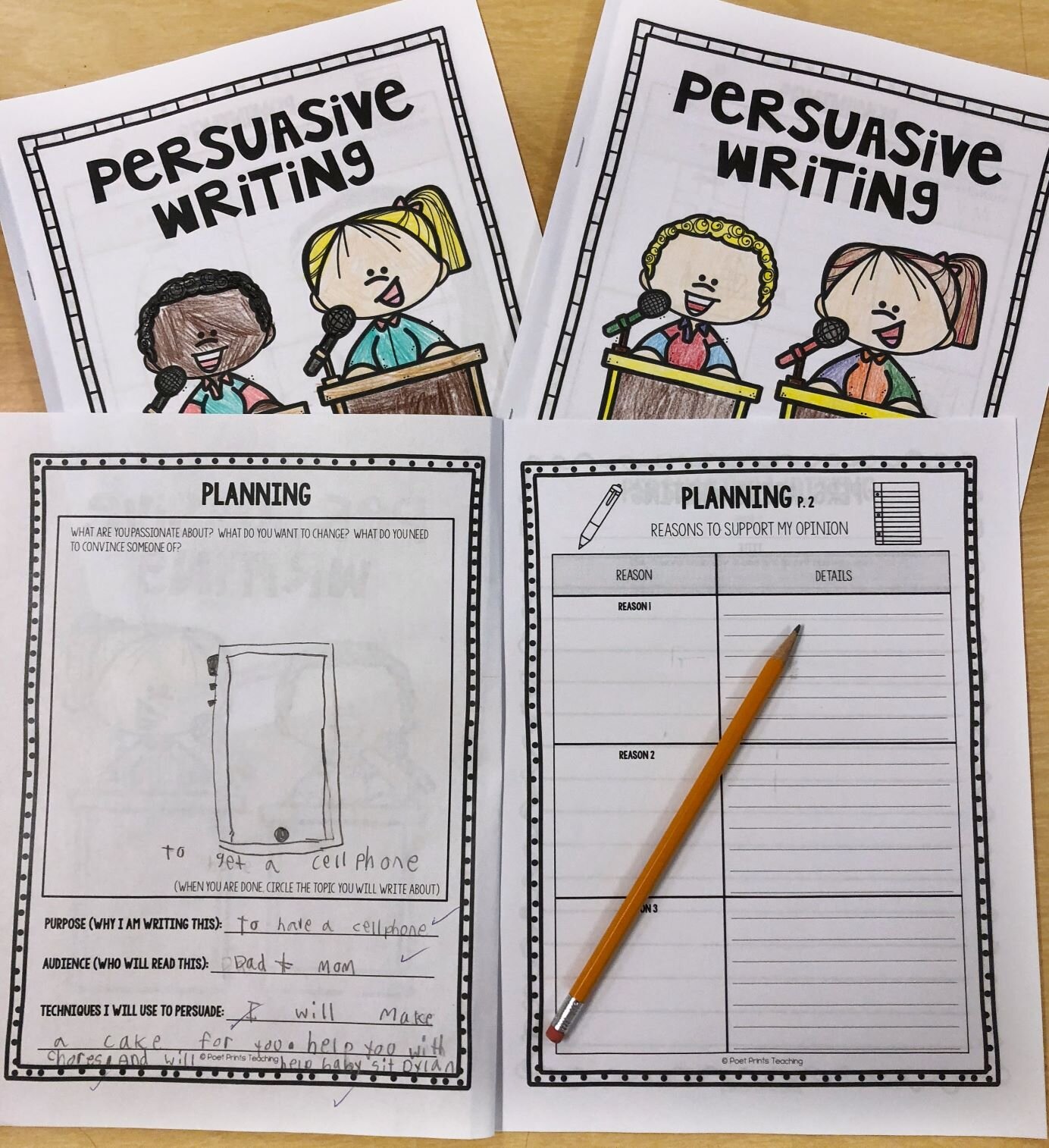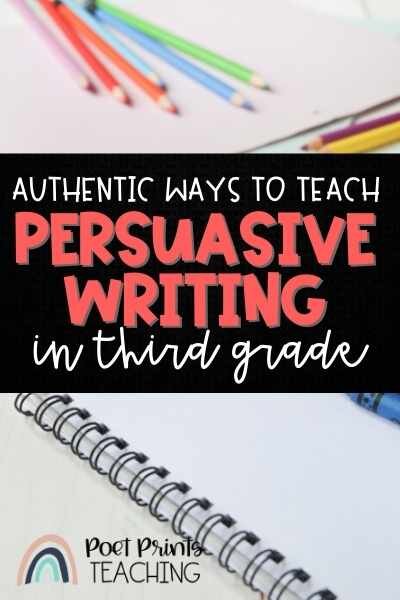Persuasive Writing in Third Grade
The art of persuasion. It seems that many kids do their very best to persuade their parents, friends and, yes, even teachers to see their point of view. Kids are excellent at trying to persuade others to do their bidding. Even my toddler seems to be honing her skills, always trying to find ways to convince me to leave Paw Patrol on for “just one more episode.” But learning the art of persuasive writing can be tricky. So here are some tips that I’ve learned for teaching persuasive writing in Third Grade.
Text: Teaching persuasive writing in third grade.
Image: School supplies are displayed on a table.
How Do You Teach Persuasive Writing to Third Graders?
You might be asking yourself: How exactly should I be teaching persuasive writing to Third Graders? Well, over my years of teaching, I’ve found that keeping it as relevant as possible is key. Don’t force kids to create persuasive writing about things they aren’t actually passionate about. Very few kids want to do a persuasive writing piece on if dates or prunes are better for you…..OK, OK….. I hope that no teacher would ever make their students write about that topic, but the point still stands. Give them topics they can get passionate about.
There are so many topics that students could write persuasive arguments about. Here are some ideas:
Which makes a better pet:
Dogs vs. Cats
Snakes vs. Hamsters
Sharks vs. Alligators
Should kids be allowed to:
Be principal for the day
Own a cell phone, tablet, laptop...really, any type of technology
Bring a cell phone to school
Bring a pet to school
Drive at a younger age
Play video games all day
Which is Better:
Soccer or Baseball
Bowling or Mini Golf
iPhones or Androids
Summer or Winter
Winter break or Summer break
Chapter Books or Picture books
Reasons for:
Longer recess
No homework on the weekends
No homework ever
More snack options in the cafeteria
Getting a new pet
Going to Disneyland on a vacation
Going to Hawaii on a vacation
Going to Mexico on a vacation (can you tell that I really want to go on vacation?)
Spend less time planning!
Looking for a FAST way to plan out a persuasive writing unit? In just a few clicks you can grab all of the pieces you need: a lesson plans, anchor chart samples, planning pages, rough and good copy student sheets, and assessment! Just print… that’s it.
Use a Mentor Text to Teach Persuasive Writing
So, now that you have some ideas, it’s time to teach your students what the word “persuade” means. I like to write this word on an anchor chart and then read a mentor text that is a piece of persuasive writing. I’m a big fan of using mentor texts during writing lessons.
When teaching persuasive writing, I love the story “I Wanna Iguana” by Karen Kaufman Orloff and David Catrow. This story is a series of letters between a mother and son. In his letters, the son is trying to convince his mom to let him get a pet iguana. In her letters, she is making counter arguments against his reasons for getting an iguana. Some arguments are good and some aren’t as good. In the end, Alex’s reasons prevail and he gets his iguana. While this is my favorite mentor text to use when teaching persuasive writing, there are plenty of other great mentor texts out there.
Here are a few great mentor texts for persuasive writing:
Can I Be Your Dog? By Troy Cummings
Rufus Goes to School by Kim Griswell
The Big Bed by Bunmi Laditan
Escargot by Dashka Slater
Purple, Green and Yellow by Robert Munsch
Discuss Ways to Persuade an Audience
Persuasive Writing: A type of writing that tires to convince a reader to agree with you.
How can we persuade readers? What do we want?
After reading the story of your choice, talk about the techniques that the authors use to persuade an audience. Make sure to pull out specific examples of the language used in the story so students can replicate the language in their own writing. Then have students brainstorm other ways to persuade a person or audience. They might come up with ideas like offering a gift or incentive, using humor, appealing to a person’s emotions, scaring the audience into doing something, or using logic.
Show Examples and Non-Examples of Persuasive Writing
Next, we need to show examples and non-examples of persuasive writing. An argument isn’t always a good argument (as seen in the book I Wanna Iguana). Students need to see that some techniques to persuade aren’t effective.
We should also talk with students about when they might have seen examples of good persuasion and poor persuasion in their lives. Social media, magazine ads, billboards, radio ads, and commercials all use the art of persuasion. Drawing students’ attention to this will be helpful when they try to write their own persuasive essay.
Reread your mentor text and pause after each argument made in the story. Ask students if they think the argument was a convincing argument or not. Record the convincing and unconvincing arguments on an anchor chart so students can visually see all the arguments. This will help students more easily determine the difference between good and bad arguments.
Write our Own Persuasive Essays
As you can see, there are a lot of steps before students actually start writing. In order to set students up for success in creating their own persuasive essay, they need to understand what makes a good argument. Before they start writing, they need to do some planning. And before the students can do the planning, you need to model what this would look like.
Students begin planning their persuasive essays. In this example a student is planning to persuade their guardian to buy them a cellphone.
Draw up a sample planning page on the whiteboard or on an anchor chart and walk students through the planning process. First, start with recognizing the audience. For instance, trying to convince parents to take you to Disneyland, or trying to convince your brother to start a paper route with you, or trying to convince your teacher to stop giving homework. Then have students plan their arguments.
After planning out the writing, students can write their rough copies. Give students time to edit their work. Finally, they can complete the good copies.
If you want to save yourself some time, I’ve created all these resources for you in my Persuasive Writing mini-unit package. There are detailed lesson plans broken down into five parts, differentiated planning pages, writing pages, a checklist to help with their editing, and evaluation pages for their writing. There is even a digital template included for distance learning or Google Classroom
Share the Persuasive Writing - Ideally, with a Real Audience
After the good copies are finished, I love giving my students a chance to share their writing with an audience. If they wrote letters, they could read the letters to the appropriate people. They could post their essays on a bulletin board for people to read. They could read their persuasive writing to their peers. I think sharing and celebrating the finished product is important!
The art of persuasion is important. Teaching persuasive writing can be time-consuming, but it’s so worth it in the end.
Text: Authentic Ways to Teach Persuasive Writing in Third Grade
Image: Text is displayed over school supplies





